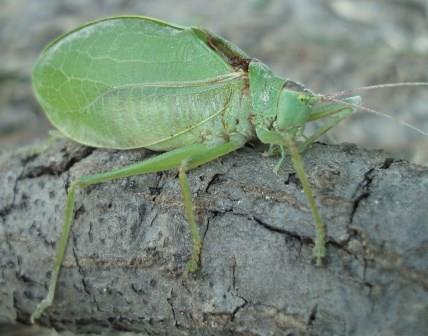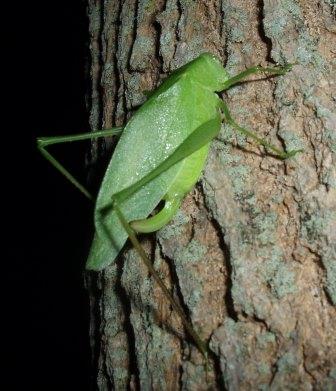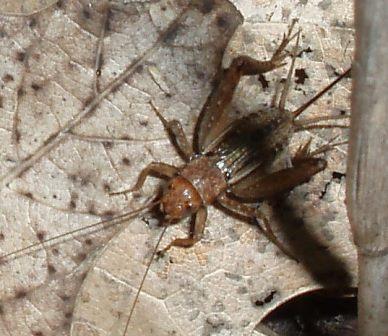by Carl Strang
I wasn’t sure how I wanted to start this one. There’s an element of embarrassment, which might be good in a blog despite my personal discomfort. There’s the straightforward information approach, but that would leave out too much. This is a science-themed blog in the end, and I decided that perhaps that is where the emphasis should be. Science is not a body of knowledge. Science is a process, and it’s conducted by human beings, so it gets messy. Errors and false starts, egos and self deceptions all play an important and regular part.
Early in my study of singing insects, on 30 June 2006, I heard the year’s first meadow katydids singing in the dolomite prairie at Waterfall Glen Forest Preserve. I recorded the songs, took photos, and collected one. It was one of the large meadow katydids (genus Orchelimum).

It seemed to me that the habitat, the song, and the cerci (small clasping structures at the tip of the male’s abdomen) of the specimen best matched reference recordings and drawings of the common meadow katydid (O. vulgare). I posed the dead specimen to get a sharper photo than I had gotten of live insects in the grasses.

From that day until last Thursday I continued to treat these insects as common meadow katydids. The only odd thing about them seemed to be their infrequent inclusion of “ticks” in their song. That needs some explanation. There are a lot of meadow katydid species, and their songs have a tick-and-buzz pattern. Their wings have a sort of comb and file structure. Moving these together slowly produces separate “tick” sounds, vibrating them rapidly produces the buzz. A typical song begins with a few ticks, and ends with a buzz. The many species produce an impressive variety of variations on this basic pattern. All reference recordings of common true katydid songs included several ticks before the buzz. I wasn’t hearing them very often.
That brings the story to last Thursday night, when I presented a fireflies program at north Blackwell Forest Preserve. After I gave the interpretive talk to introduce the program, we walked to the nearby woods to see the light show. On the way we passed a large grassy meadow, in which there were a lot of katydids singing. Their songs were long rattling buzzes, and didn’t quite match familiar patterns. After the program was done I stayed, and found one of the singers to photograph.

Clearly this is a large meadow katydid. In the process of stalking it I impressed the song on my memory. Back home I played my reference recordings, and found a perfect match in the gladiator meadow katydid (O. gladiator). My first feeling was elation, for this species was on my list of those which should be in northeast Illinois, but I had not yet found it.
The more I thought about it, though, the more questions arose. First, there were dozens of these insects in that meadow. How could I have missed them over the previous three years? Second, my impression from reading about gladiator meadow katydids was that they are a marsh species. What were they doing in an upland meadow? McKee Marsh is nearby, but many of these gladiators were singing a couple hundred yards above that wetland. I realized then that I needed to review references for both the gladiator and the common meadow katydid, because I may have identified these incorrectly from the beginning.
I listened, again, to all my reference CD’s and to recordings I had made of “common meadow katydids” in 2006. I found that there was a lot of variation in the reference recordings. All of the recordings attributed to gladiator meadow katydids had the rattling quality I heard Thursday night. Some of the recordings of common meadow katydids had a tighter buzz with no rattle, but others had the rattle, instead. The nighttime songs at Blackwell were very long buzzes, but the reference songs attributed to gladiators varied. Some were as long as those at Blackwell but others were short, like those of common meadow katydids. All of my own recordings proved to have the rattling quality, all had been made in daytime, all had the briefer length.
I had accumulated more books and articles since 2006, and I went through that material. For instance, Elliott and Hershberger in their recent book, The Songs of Insects (a link to their website is in my left blog frame), caution that the common meadow katydid is “Not nearly as common as its name implies” and that it is very similar in appearance to the gladiator. In their entry on the gladiator, they say that it is common, and describe its habitat as “tall grassy areas, often near water.” More enlightenment was provided by Alexander, Pace and Otte in their 1972 paper, “The singing insects of Michigan.” They indicate that the common meadow katydid is a late season species that “replaces” the early-season gladiator meadow katydid around the end of July or beginning of August. However, in Michigan they found the gladiator only in marshes.
Other references emphasized the physical similarity of the two species, to the point where males sometimes interact aggressively with one another (usually members of different species ignore each other). Furthermore, there were indications that they have different song variations for day and night.
So, armed with this information I returned to Blackwell Friday evening. I made a recording of the extended rattling song, and collected a specimen. A careful review of the new specimen and the one from 2006 forced me to conclude that both were gladiators. So, now I tentatively conclude that all the “common” meadow katydids I previously had recorded for July are in fact gladiators. In 2006 my last observation of this species was 25 July, in 2008 was 26 July, apparently ruling out the possibility of common meadow katydids in those years. In 2007 I have a couple notes from the first half of August, but by then the issue is confused by the presence of abundant black-legged meadow katydids (O. nigripes). These have a distinctive appearance, but a full tick-and-buzz song, so now I need to listen and look more carefully to large Orchelimum in August, because at the moment I have no unambiguous observations of common meadow katydids in DuPage County.
So, one lesson is to remember that in science, it’s a good idea to stay open to new information. In field work, look and listen freshly all the time for new things to notice. Hold onto your ideas lightly. Also, take all reference material with a grain of salt. In this case I found many ambiguities and contradictions even among refereed technical publications.













































